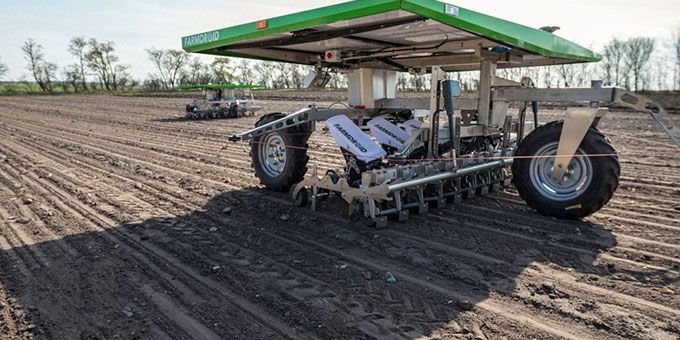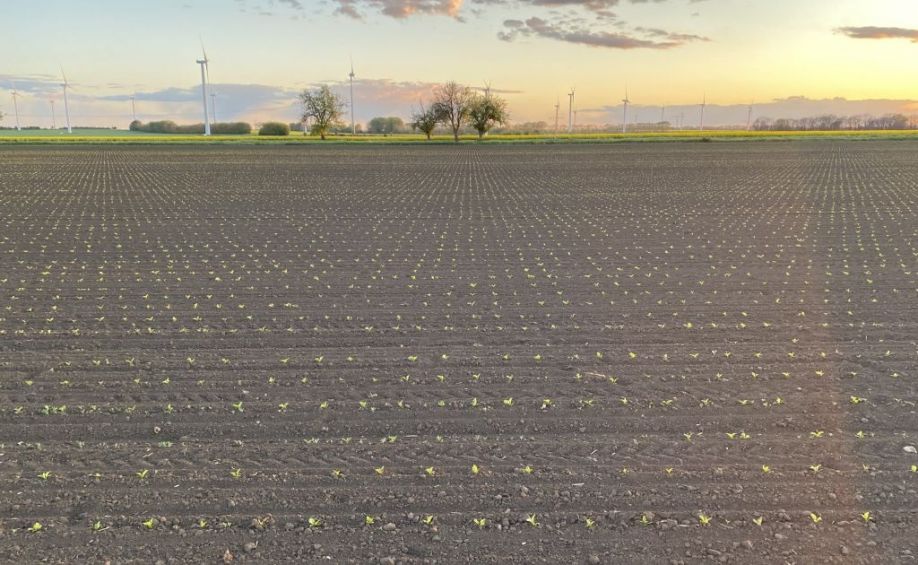We need to focus more on autonomous machines in agriculture – what machines are on the market, what are the advantages and why farmers should adopt this technology. The awareness has already improved the recent years, but we need to do better.
 Fully Automatic Robot for Sowing and Weed Control
Fully Automatic Robot for Sowing and Weed Control

Q&A with Mia Heuschkel of | FarmDroid
Tell us about yourself and the story behind FarmDroid?
FarmDroid is the world’s first autonomous seeding and weeding robot. The robot is fully solar powered. It runs on solar energy, which makes the seeding and weeding operation completely CO2 neutral. The four solar panels placed on top of the robot produce power for a battery package that ensures up to 24 hours daily and CO2-neutral operation. Using high precision RTK GPS technology, FarmDroid seeds the crops in the field and marks the exact position of every single crop. Since it knows precisely where each crop is placed, it can perform weed control both between the rows and inside the rows between each plant. It can even start weeding before the plants germinate to ensure a clean field. Given that the FarmDroid only weighs 900 kg, it preserves the soil’s microstructure.
FarmDroid was founded in 2018 by the two brothers Jens Warming and Kristian Warming who origin from a family of farmers. The company was founded together with the innovation environment Syddansk Innovation and the acknowledged robot expert Esben Østergaard who founded Universal Robot.
The idea of FarmDroid came to Jens in 2011, when he was hand weeding sugar beets on his family’s organic farm. He was overwhelmed with the amount of manual work that the sugar beets required and thought to himself that there had to be a smarter way to do it. That was when he started developing the concept of the FarmDroid robot – an automated solution for weed control. Later his brother Kristian joined the adventure. At first Kristian was only a sparring partner for Jens, but over time the robot project became too interesting to remain on the sidelines. Kristian chose to jump on the train, which quickly turned into a lightning train. In 2019 they sold the first commercial robot.
So far, FarmDroid has sold more than 400 robots worldwide. We have robots running in most of Europe as well as in UK, Ireland, Canada.
What challenges and tasks does it solve for the farmer?
FarmDroid takes care of seeding and weeding. When it has seeded the plants, it knows the exact position of each seed. Therefore, it can weed before the plants start to germinate. This concept is also known as blind weeding. Moreover, it keeps the field clean by weeding both between the rows and inside the rows between the plants. Running on RTK GPS technology, the robot can weed with down to 8mm precision. The farmer gets an enhanced yield of his crops because of the robot’s extremely precise weeding.
Weed control performed manually by hand is an extremely time-consuming and tiring task. In recent years it has become difficult for farmers to find manual labor to hand weed their crops. FarmDroid eliminates the need of manual weed control, thus reducing the costs for the farmer. The farmer saves the costs for the workers both with respect to salary and living costs. Moreover, the robot is solar powered, so there are no costs for fuel when operating the robot.

The robot is fully automatic, and you do not have to supervise it while it works. Once it is up and running, you can let it work in the field by itself for the entire season and settle for checking up on it occasionally. Therefore, it leaves the farmer with much time to take care of other tasks.
Modern farm machines are becoming heavier and heavier, damaging the delicate ecosystem of the soil. We put a lot of pressure on the soil with our heavy farm machines and their enormous weight is squeezing the life out of the deeper soil layers, potentially reducing plant growth and thus crop yields across the globe. With its weight of only 900 kg, FarmDroid is a lightweight field machine. In this way, it protects the soil. It lets the soil nourish its organism and plant roots, so that we can continue to cultivate healthy crops. Thus, it eliminates the risk of damaging the soil’s ecological functioning.
With global warming and the increasing focus on sustainability, FarmDroid addresses many of the farmer’s challenges. It makes seeding and weeding CO2-neutral by operating on solar energy and taking care of the field without or drastically reducing the use of harmful chemicals.
What do you see as the biggest hurdles farms face in implementing autonomous vehicles like FarmDroid?
New ways of farming can be scary for many farmers. Farmers often have their own way of doing things. One of the main hurdles is lack of trust in new technology and robots. The robot takes some control out of the farmers hands and that can be a huge challenge to overcome. The farmer needs to be convinced that the robot can give him good results. Since farming robots are still relatively new in today’s agriculture, there is limited proof of results. Implementing autonomous vehicles is a huge leap for the everyday farmer. Even though we have many successful cases, farmers differ from country to country. For a farmer from Italy a good case from Germany is not necessarily sufficient to convince him.
In many ways an autonomous vehicle like FarmDroid differs from what the farmer is used to – it runs on solar energy, it can work without supervision, and it does not look like a tractor. That can be a big hurdle for many farmers to overcome. For this reason, it is important to make the robots user-friendly and use technology that the farmer is somewhat familiar with. We have done that with our robot and once the farmer understands the robot, it is not so far from what he knows.
How can these hurdles be solved to accelerate adoption of technology like this.
We need to focus more on autonomous machines in agriculture – what machines are on the market, what are the advantages and why farmers should adopt this technology. The awareness has already improved the recent years, but we need to do better. Increased awareness of autonomous vehicles in agriculture is important.
To establish trust, it is crucial that we share insights and customer stories. The farmer is easier convinced by another farmer. We need to demonstrate the technology at shows and field days and meet the farmers eye to eye. Farmers are incredibly knowledgeable within their field. It helps them understand the product if we share facts and details. The customer journey for a product like ours is long, so we need to be there every step of the way to convince the farmer. Also, we have a customer care setup where we can help and monitor the robots so we quickly can help if any issues arise.
The technology should be user-friendly. When the farmer decides to invest, it should be easy for him to get started.
How do you see farming evolving with robots and automation?
Climate change is a big threat to agriculture in general. Every year there is a global drop in yield because of drought, heat, and general weather volatility. Pests and diseases become a still bigger threat as more and more chemicals are forbidden. New methods of weed management and climate friendly pest controls must be developed. It is getting increasingly difficult to find workers in the agricultural sector, which has to be solved with the increasing focus on more sustainable growing methods. There is a huge potential for autonomous farming robots to solve these challenges for farmers.
Farming is already technologically advanced in many areas, but I think we will see even more adoption of new technologies to help farmers reduce costs and increase yield as well as address the urging climate threat. I also believe that with robots and automated solutions, we will see a shift to smaller machines to reduce soil compaction and improve soil health.
Can you link the technology of FarmDroid to combating climate change?
As our robots are all powered by solar panels, there are no emissions from the seeding and weeding operation. Thereby we help the farmer to reduce CO2-emissions from his production.
Another big problem in current farming methods is the increase in size of machinery. Big heavy machines cause soil compaction, which raises nitrous oxide emissions. This has an almost 300 times bigger greenhouse effect than CO2. At the same time, it damages soil health making it more difficult to produce crops year after year.
To combat world hunger, it is important to get as high a yield as possible from each hectare being farmed. As our robots nurture the crops from seed to harvest by constantly fighting weeds, it helps to increase yield from each hectare.
What does the future hold for FarmDroid?
We have already experienced great interest in our technology. I expect that the interest will only increase. We are seeking to enter new markets to make the FarmDroid available for more farmers. We continuously expand the range of seeds that the robot can handle. For the future we intend to test more seeds and expand the capability of the robot. As the capacity for a single robot is limited it is still scalable by just implementing more FarmDroids on the field(s).
About FarmDroid
FarmDroid is the world’s first fully automatic robot that can take care of both sowing and weed control. With the FarmDroid robot we help farmers and plant breeders reduce their costs of sowing and weeding and we even do it in a CO2 neutral and ecological way. The company FarmDroid ApS was founded in 2018 by the two brothers Jens Warming and Kristian Warming together with the Danish innovation environment Syddansk Innovation A/S and the acknowledged robot expert Esben Østergaard. So far in 2022, the FarmDroid has already seeded and weeded 18.000 hectares spread over UK, Canada and large parts of Europe.
The content & opinions in this article are the author’s and do not necessarily represent the views of AgriTechTomorrow
Comments (0)
This post does not have any comments. Be the first to leave a comment below.
Featured Product

